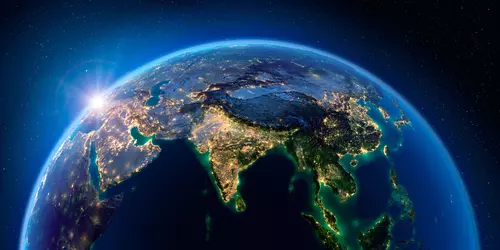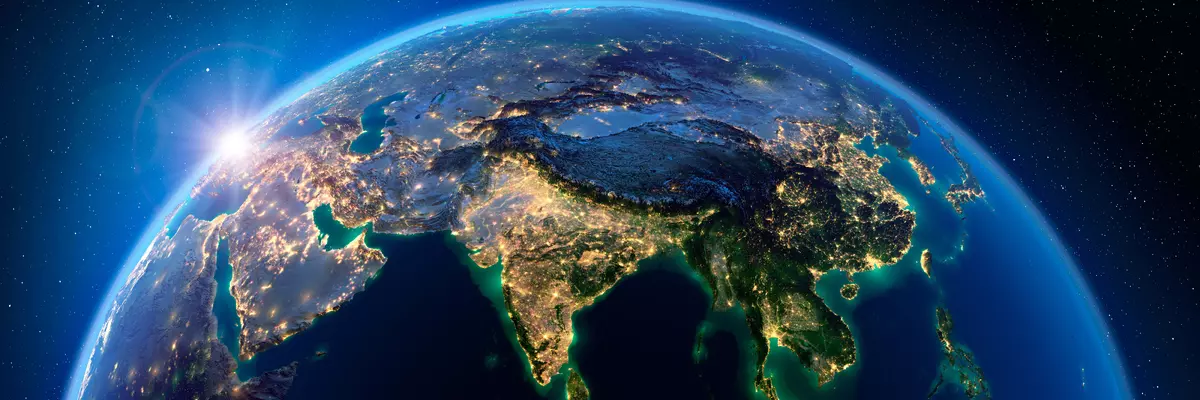The climatic year of Asia
Who travels to Asia, is on the continent with the largest land mass of this earth and with more than 44 million km² area almost one third of the land mass of our earth belong to this continent. But Asia is not only an independent continent, together with Europe it forms the common continent Eurasia. The continent of Asia can be divided into 5 regions, so that West Asia (Middle East), Central Asia, East Asia (Far East), South Asia (Indian Subcontinent) and Southeast Asia with their different climatic conditions can provide the traveler with a vacation destination with ideal temperatures at any time of the year.
As a traveler, you can find the most diverse landscapes in Asia, so that even steppes and deserts can become a vacation destination. For example, the Gobi Desert can be found in Mongolia, the Taklamakan Desert in China, and the Thar Desert is located in western India. If you are looking for the challenge of a mountain climb, you can conquer the 14 highest mountains in the world on the Indian subcontinent. Thereby, a trip to the Himalayas can provide one of the last great challenges, if one wants to climb Mount Everest, which with its 8848 meters is the highest mountain on this earth. Geological highlights of this continent, however, are the many volcanoes of this region. Kamchatka, the Russian peninsula, alone can offer 160 different volcanoes. Alone 28 of these volcanoes are still active today and if you travel further to the Philippines you can also find 20 active volcanoes here. Japan, China, Vietnam or the Andamans, everywhere the traveler can make these natural beauties beautiful motives of his vacation photos.
General information about Asia
Also countries like Thailand, Sri Lanka and India enjoy great popularity as a travel destination. Here the traveler will find an interesting mix of traditional cultures and modern metropolises. The natural beauty of Asia can enchant and for the art and culture fan can be found on this continent numerous attractions.
Especially a country like China can now become an interesting travel destination and once you have visited the forbidden city in Beijing you can take a look at the historical development of Chinese culture. As early as the 7th century BC, the construction of one of the most massive architectural monuments in the world began, and anyone traveling to Asia should also visit the Great Wall of China. On a length of 21,190 km come latest calculations and on the well-preserved areas of the wall you can see at any time tourists admiring this extraordinary structure. One of Asia's most beautiful buildings is the Taj Mahal, located in the state of Uttar Pradesh, which demonstrates the great skill of Indian architects. Designed as a mausoleum, one can find tombs under the crypt and millions of travelers love the Taj Mahal as a photo motif at dusk. If one wants to experience modernity in perfect combination with historical sights, then a trip to Japan is the best choice. Here the tourist can visit the Tokyo Tower and, like millions of vacationers before him, admire one of the landmarks of the metropolis of millions Tokyo and take a look at this fascinating city from the Tower. Angkor Wat, Floating Markets, Big Buddha Statue or the Khaosan Road - if you want to travel Asia, you will experience hospitable people, a culture rich in tradition and exotic culinary delights.
Tourism Asia
West Asia (Middle East)
In this region of Asia, the vacationer can find a climate that can be described as very dry. There are areas like the Negev desert or the deserts in Saudi Arabia, where in summer the temperatures can even rise up to 50 degrees. Characteristic for the region are months without rain, where between night and day are high temperature fluctuations. Thus, the vacationer can find areas that can offer hot summers as well as particularly cold winters. In addition, there are zones on the Caspian Sea and the eastern Mediterranean with subtropical climate all year round.
Central Asia
From Mongolia to Kazakhstan, the climate is dry from January to December, but there are also areas that can record desert and steppe climates. Depending on the vacation destination, temperatures can vary greatly, so that it can be up to 40 degrees plus or minus. What is noticeable, however, is usually an extreme heat, which is characterized throughout the year by the fact that in these Asian regions rain falls very rarely.
East Asia (Far East)
Just a country China can offer different climates in this region, so that the south can offer tropical monsoon climate, the northeast can present cold winter climates. If you want to experience extreme weather, you should visit Mongolia, where summers can be very hot, but the long winters starting in October offer temperatures that can even drop below 50 degrees below zero. Steppe and desert climate in central China, mild monsoon climate in the east of the country, on the other hand, Japan and Korea can even boast the usual four seasons.
South Asia (Indian Subcontinent)
If Pakistan and India offer subtropical climate, the vacationer can find here even temperatures in the summer of up to 50 degrees. On the other hand, countries like Bangladesh, Bhutan or Nepal, which have a monsoon climate, can offer a lot of rain throughout the year. The traveler will find a tropical climate in Sri Lanka and those who want to experience a white winter should spend these months in the north of Bhutan and Nepal.
Southeast Asia
Vacationers travel to humid regions with year-round precipitation when they visit Malaysia or Java, although the entire region of Southeast Asia from January to December can rather be described as humid and tropical.




















